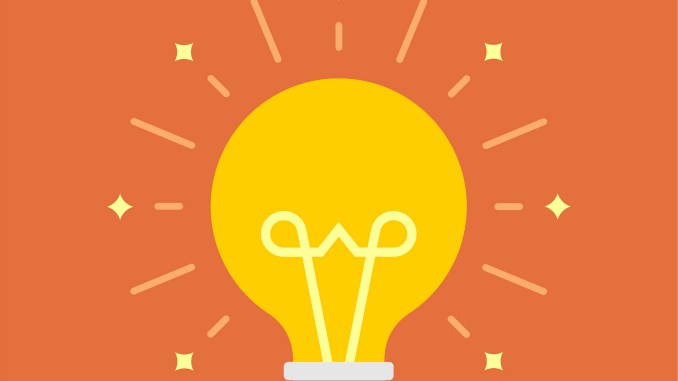Insight: The Anatomy of an Aha Moment
10/27/2017
By Molly Rose Teuke
A moment’s insight is sometimes worth a life’s experience. — Oliver Wendell Holmes, Sr.
How are you at coming up with a good idea? You know, that flash of awareness that solves a problem or answers a question that’s been nagging at you. It’s often a connection that comes to you out of the blue. Wouldn’t it be handy to reliably have those aha moments when we need them?
Another word for an aha moment is insight—a bright idea or a solution from our subconscious that pops into our awareness in a heartbeat. It’s what happens when we make new connections across existing knowledge in our brains.
MENTAL MAPPING
We used to believe our brains were done changing by the time we reached adulthood. We now know that we grow new brain cells every moment of every day throughout our lives. And those brain cells—our neurons—are organized more like points on a map than like cogs in a machine. We create new brain maps every time we try to solve a problem.
In “A User’s Guide to the Brain,” Dr. John Ratey writes, “The brain is not a neatly organized system…it’s often compared to an overgrown jungle of 100 billion nerve cells, or neurons…which intertwine to form an interconnected tangle with 100 trillion constantly changing connections.” No wonder we need personal brain maps to find our way around.
All those neurons and tangles make up our mental databanks, and we can think of them in two ways. First, there’s the databank that’s readily accessible to our prefrontal cortex (where we do that thing we call thinking). Then there’s the rest of the data in our brain, the data we can’t always access easily. If you imagine the readily accessible data as a park, you would need all the rain forests on earth to represent the rest of the data we carry around upstairs. Most of us have well-traveled roads in our brains to navigate the park. Maps of our mental rain forest, if they exist at all, are mostly made up of overgrown logging roads.
Much of the time when we try to solve a problem, we’re drawing on data that’s in the park, but sometimes we have to reach into that vast store of knowledge that’s contained in the jungle. In order to have an insight, we need to forge new pathways to get to it.
WHAT’S THE POINT?
Insight is one way we solve problems, especially problems that we can’t reason out in a logical fashion. Our mental maps reflect all the different routes information travels in our brains—they represent all the connections from one data point to another. An example of a well-traveled road is the route we use to access all the information we need to drive a car. The route we would take to assemble a complicated tool that we haven’t used in awhile would be more like an overgrown dirt road—and sometimes there just isn’t an existing route.
That’s where insight comes in. An insight—thinking about something in a new way—is what happens when we connect dots that hadn’t been connected before, or when we reconnect old dots. It’s what happens when we essentially alter our brain maps by creating new maps with new pathways.
Sometimes we need insight just to get out of a mental rut.
Einstein famously said: “We cannot solve our problems with the same thinking we used when we created them.” In other words, we have to go beyond our existing maps. We have to forge new mental pathways through the rain forest in our heads.
WHAT DOES IT TAKE?
Understanding the conditions that make insight possible makes it easier to have those aha moments when you need them. Where are you and what are you doing when you get your best ideas? I thought so…in the shower, when you’re exercising, maybe when you’re driving or when you’re just waking up. These situations all reflect conditions that make insight possible.
The first condition is a quiet, calm mind. When we have an insight, we’re often drawing on knowledge or experience so deep in the jungle that we didn’t even know it was there. Imagine a group of school kids. When you pose a problem, there are plenty of kids in the front waving their hands and shouting, “I know, I know!” But chances are pretty good they’re going to give you the same old answers they always give you. Then you’ve got the kid at the back who’s very tentative, barely raises a hand, and yet might have exactly the right answer. You need to get the loud kids to pipe down so you can hear the quiet one. We need to quiet the conscious part of our brain enough that we can hear those quiet signals when they try to get through to us from deep in the forest.
The second condition is a slightly positive frame of mind, because when we’re feeling good, we tend to be more curious, interested and alert—and more likely to think creatively. This is related to another key operating fact about the brain. Everything our brains do, every decision they make, starts with this question: Is this a threat or a reward?
When our brain is in threat mode, our field of vision narrows, and we literally see less. We’re also less open to new ideas. Even a very mild threat state can hinder our problem-solving creativity.
Third, we need to filter out distractions. We might close our eyes, or look up and away for a moment, or turn down the sound on the radio. Anything to tune out whatever’s going on around us.
The fourth condition is taking your mind off the problem. You know how it is when you try to remember the name of someone you saw in a break-out session…try as you might, you cannot come up with it. But put it out of your mind, and what happens? You’re driving home, and poof!, it just pops into your head.
Thinking harder is often not a very good way to come up with a solution. You have to let go of the problem or your brain gets in a rut and you keep thinking the same old thoughts. You have to let go of the wrong answer to let the right answer come into your conscious awareness.
Once you let go of wrestling with the problem, you allow your mind to range a little further afield. The answer is there, it’s just not in a neatly labeled file drawer in your brain. It’s somewhere out there in that jungle, and sometimes, we just have to let the answer find us, instead of the other way around. Creating a new mental map makes that possible.
These insights about insight suggest an answer to “How can I have more bright ideas?”
First define the problem with clarity. Be crystal clear on the question you’re trying to answer. Then get your conscious brain out of the way—stop thinking so hard about it. Go for a walk, read a book or have lunch with a friend. Let your subconscious do the heavy lifting while you’re doing something that’s more fun.











